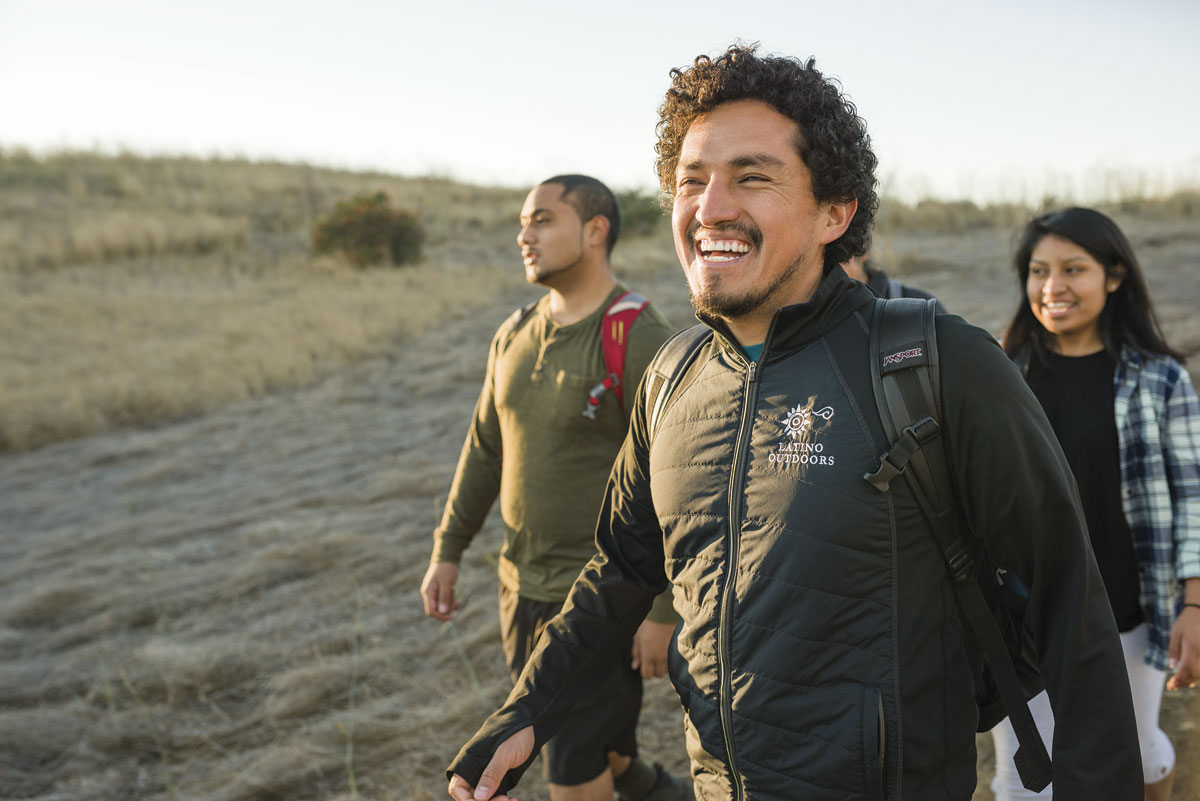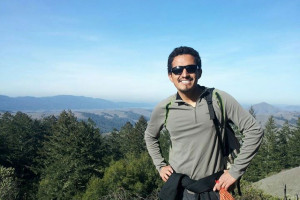Not long after the fog recedes and the sun starts to warm the beach in the late morning, a small bus arrives, and a mix of English and Spanish conversations spill out. The passengers disembark, carry their few belongings over the sand, and gather around Alicia Cruz and José González. The group of two dozen stands on Heart’s Desire Beach in Tomales Bay State Park in west Marin County, and Alicia and José ask if anyone doesn’t understand English. Two hands go up, so they begin their introductions in Spanish. What looks like an introductory kayaking trip to some is a cultural expedition for others.
In the circle stand two families with a handful of kids and teenagers, a few adults, state park employees, volunteers from the nonprofit Environmental Traveling Companions (ETC) to guide the kayaking trip, and the leaders of Latino Outdoors, a nonprofit devoted to connecting Latinos with nature.
“This is the second time I’m paddling,” Raul Hernandez tells me in Spanish. Hernandez is originally from Mexico but came to the U.S. when he was 9; his wife, Olga, crossed the border when she was 25. Now in their mid-30s, the Hernandezes and their two young daughters are becoming Latino Outdoors excursion regulars, but the girls have stayed home today, Olga explains. “They love it, but today is for adults. I don’t know how to swim, so I wouldn’t be comfortable taking them on the water.”
Latino Outdoors was born through unexpected circumstances, beginning with González’s start in life in rural Mexico. “I remember in my little village you never asked or knew if the land around was private, a state park, a refuge, or what. I learned those concepts here in the U.S.” His family immigrated to California’s Central Valley when González was nine, and he lived in Tulare for a year and then for the next nine years in Turlock, 20 minutes south of Modesto. His mother worked in the fields and later in an industrial laundry facility for hospitals and hotels. His father worked in a chicken cannery. At first, “I was the only one in my family who had an interest in nature,” he says; he learned about U.S. conservation and the systems supporting it, in school.
While González was working on his master’s degree in natural resources and the environment at the University of Michigan in 2009, he began searching for American Latino organizations focused on conservation. “I found nothing,” he recalls. But four years later, González had an opportunity to create what he’d discovered was missing. Working with Tuolumne River Trust, he began talking to Latino communities about the outdoors, asking what they needed to get out and enjoy it, and chronicling their stories online. With that information he was able to help connect the Environmental Action Committee of West Marin with local community groups to bring a group of Latinos to Drakes Bay.
Alicia Cruz organized Boy Scout members and a family to join the trip, “and that’s the way we started it,” González recalls. Soon Latino Outdoors had a grant from the Resources Legacy Fund, and today there’s a vibrant Facebook page, website, blog, and social media channels where Latinos from all over the country connect to the volunteer-powered organization. It’s grown to more than 40 leaders in six regions, with national directors, regional coordinators, ambassadors, communication directors, media contributors, special project contributors, and more.
When Cruz first encountered Latino Outdoors, her life was at a turning point. She had married young to escape abuse in her family, left school, had a daughter, and then divorced. In search of a new beginning, she turned to nature and began working for the Boy Scouts, though it wasn’t her first experience outdoors. Born and raised in Mexico City until age 9, she used to visit the Bosque de Chapultepec, the city’s main green area. “I went to row on Chapultepec Lake to enjoy nature,” she says. Then when she lived in La Paz, Baja California Sur, for a year, she spent nights sleeping on the beaches due to her father’s unstable personality. “I knew nature by camping and sleeping outdoors at times when my dad didn’t have a place for us in La Paz, or when crossing the border.”
While working for the Boy Scouts, she learned about hiking and later backpacking—what equipment to bring, how and where to pitch a tent. She ventured by herself to Oregon and Yosemite and took a two-week excursion to Utah to visit its national parks. “It was like being on another planet, peacefully contemplating the stars, without thinking of rushing to get up and leave.”
Cruz is now the Latino Outdoors coordinator for the North Bay and, inspired by her experience with the Boy Scouts, has developed a family hikes program. She offers Wellness Walks, as she’s dubbed them, at least once a month and has cultivated a group of mothers who attend and volunteer regularly.

Raul, Olga, and the others return to Heart’s Desire Beach from kayaking to board the small bus back to San Rafael. “It was so beautiful,” Raul says. “We rowed around the bay and stopped on a beach for lunch.” Before leaving, group members clean the kayaks together and put away the equipment. “It’s good to learn all the work this takes,” Raul says. “Not just coming and enjoying others’ work.”
Olga says she was surprised by and appreciated the group camaraderie and conversations, especially with the ETC volunteers and park officials. “You can talk to them. I love these kids, the volunteers, making an effort to talk to you in Spanish. I never have seen anything like it. I was surprised by how they talked to you,” she adds, “explaining everything and inviting you to come back”; they made her feel secure. Not knowing how to swim, she never would have gone kayaking alone.
“I was living in a rural area in Mexico, dealing with animals and working in agriculture,” Olga adds. “But the difference is that we did it to produce, survive, and have food on the table. Here it is just for fun. Very different.”
Navigating perspectives on nature in the U.S. and from the various Latino countries of origin can be summed up in a word: complicated. González notes that poverty and wealth can dictate attitudes about the outdoors as much as nationality can, and that the diversity in the Latino community—from recent immigrants to multigenerational descendants to the range of countries of origin—poses significant challenges. Nonetheless, his vision for Latino Outdoors in the coming decade is soaring: “a Latino organization that is one of the top environmental organizations in the country, along with Sierra Club, Nature Conservancy, and others.” In many ways, this is a dream come true for the U.S. conservation community, which has been searching for ways to connect with minority groups as U.S. demographics change.
González believes that even the most difficult-to-reach Latino population, recent immigrants from impoverished backgrounds, has a place in the organization. “When we were on Mount Tamalpais, starting the fire to have cookies with marshmallows, some folks said that we were wasting the fire,” he recalls. “They were used to having it just to prepare food to survive, not to sit around watching it.” He invited them to see everything differently: the fire, the woods, the park. “We tell them, ‘This is a protected park, with rules to protect it. We want you to understand and see this land in new ways, to be present in this space and be connected with a new experience, which is also for you.’” He also asks about participants’ experiences and memories. “For example, they talk about placing a comal on the hot rocks to cook fresh tortillas.”
So far Latino Outdoors has been most popular with immigrant families and with Latinos who already spend time outdoors but want to bring their cultural identity—through food, gear, stories, and traditions—to the experience. Latino Outdoors’ East Bay coordinator Melissa Avery, a first-generation American, carries a Peruvian cloth to use as a tablecloth, a blanket, and a piece of fabric to strap her youngest to her back when she’s hiking. It was a gift from her mother and helps her feel connected to her heritage and her parents, who once walked from Peru to the U.S. border.
The appeal for immigrant families is that “we can give them transportation and food for fun, outdoor activities each month,” González says. The organization’s bilingual leaders are an essential bridge for those families. Like González, Cruz, and Avery, many of the leaders immigrated as children, or their families came to the U.S. a generation or more ago, acclimating to American culture on their own. “We are expecting [immigrant families] eventually to be more and more integrated in a different country with different customs and language,” he adds, and to become more confident in the outdoors here on their own.
The Latino Outdoors leader and founder doesn’t want the organization to be viewed as belonging to him nor to suffer from being the kind of organization that disappears when its leader leaves. “First, I want Latino Outdoors to be a renowned and respected Latino environmental organization, with resources to create leaders in the field,” he says. “Then I’d like to pass the baton for the leadership to continue.” During the Heart’s Desire trip, he kept a low profile. González appreciates the importance of the role he plays, but he doesn’t expect to be in it forever. “I consider Latino Outdoors to be a great responsibility. I’m the spearhead, but I’m not alone. I have space to open doors.
“I just planted the seed,” he says. “Now, together, we are getting it to grow.”
Correction: This story has been updated to clarify that González grew up in both Tulare and Turlock, and that González’s work with the Environmental Action Committee in West Marin was part of an EAC grant.



